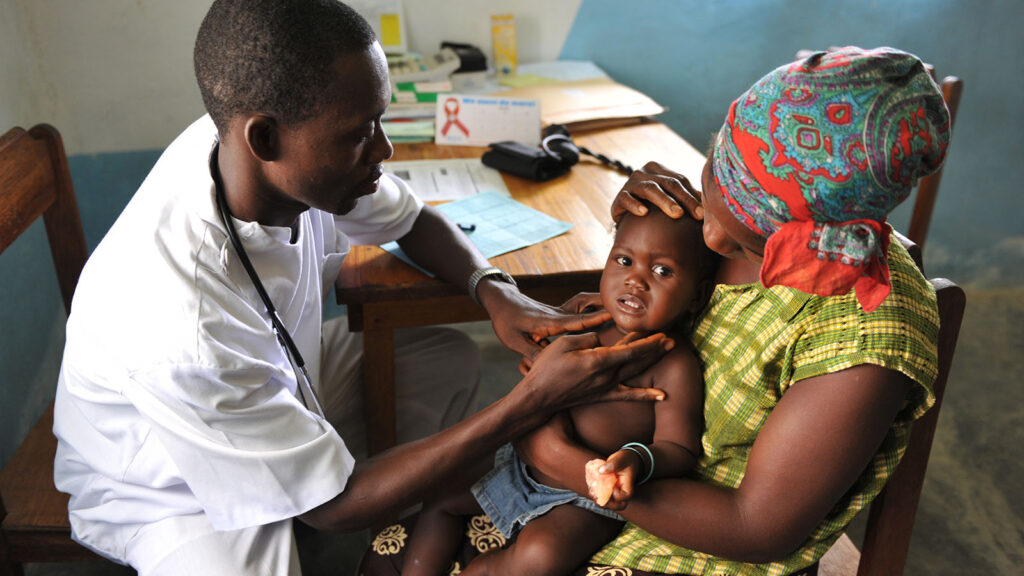Sustainable Development Goal 3 on Good Health and Well-being targets:
- By 2030, reduce the global maternal mortality ratio to less than 70 per 100,000 live births
- By 2030, end preventable deaths of newborns and children under 5 years of age, with all countries aiming to reduce neonatal mortality to at least as low as 12 per 1,000 live births and under-5 mortality to at least as low as 25 per 1,000 live births
Against this backdrop, a new report titled “Improving maternal and newborn health and survival and reducing stillbirth: Progress report 2023” and released recently by the World Health Organization (WHO) showed that Nigeria accounts for the second-highest number of maternal and child deaths globally. Nigeria, Africa’s most populous nation is only behind India in the latest ranking. The report noted that in 2020, 788 women and children died ‘per thousand’ in India and 540 women and children ‘per thousand’ died in Nigeria. In the same year, India accounted for 17 per cent of global maternal, and neonatal deaths and stillbirths, while Nigeria accounts for 12 per cent.
The reasons for this very poor ranking is not farfetched. A recent report by the United Nations Children’s Fund (UNICEF), on “Situation of Women and Children in Nigeria” revealed that Nigeria is a `country of the young’ with almost half the entire 180 million strong population, 46 per cent, currently under the age of 15. The current total for children under the age of 5 stands at nearly 31 million while each year at least 7 million babies are born. While a little over one in three of Nigeria’s whole population lives below the poverty line, among children this proportion surges to 75 per cent.
When considering the low levels of birth registration, in some areas up to 62 per cent, known data about child health issues are likely to underestimate the true scale. A 2016 national campaign linked to healthcare services resulted in the registration of about seven million children, but large population growth is impacting progress.
Nigeria’s 40 million women of childbearing age (between 15 and 49 years of age) suffer a disproportionally high level of health issues surrounding birth.
More than half of the under-five deaths (64 per cent) result from malaria, pneumonia or diarrhea. Investment in this sector has been high in recent years although the proportion of patients able to access appropriate treatment remains low
The rate of those mothers feeding new-born exclusively with breastfeeding for the first six months of life which remains stuck at around 17 per cent of infants, unchanged over the last decade. Only 18 per cent of children aged 6-23 months are fed the minimum acceptable diet. While the government has sought to improve access to primary health care nationwide, committed to reaching a network of at least one primary health care (PHC) facility in each of the country’s 10,000 administrative wards, the work is still far from complete. Coverage can be patchy, and bottlenecks in healthcare provision severe.
Poor access to water, sanitation and hygiene (WASH) remains a major challenge, contributing significantly to high levels of diarrhea-related deaths. As of 2015, 57 million Nigerians were without access to improved water sources, while 130 million people were without access to improved sanitation. An estimated 25 per cent of Nigerians practice open defecation on a daily basis.
Nigeria accounts for more than one in five out-of-school children anywhere in the world. Although primary education is officially free and compulsory, only 67 per cent of eligible children take up a place in primary school. If a child misses school for even a short time there is only a low chance, only about 25 per cent, that the child will ever return. Girls suffer more than boys in terms of missing out on education. In the north-east of Nigeria only 41 per cent of eligible girls receive a primary education, 47 per cent in the north-west. Social attitudes can also impact negatively on education rates especially in northern Nigeria. In north-eastern and north-western states, 29 per cent and 35 per cent of Muslim children, respectively, attend Qur’anic education, which does not include basic education skills such as literacy and numeracy. These children are officially considered out-of-school by the Government.
Nigerian children are vulnerable to a wide range of abuses and harmful traditional practices. The national legal framework for child protection is the Child Rights Act 2003, but to date, only 23 of 36 states have adopted the Act. Implementation is sparse with many local authority bodies unaware of their duties under the law. A national survey in 2014 found that 6 out of 10 children reported having suffered one or more forms of violence before reaching 18 years of age, with 70 per cent of those experiencing multiple incidents of violence. The country has the largest number of child brides in Africa: 23 million girls and women were married as children.
At 27 per cent, the prevalence of female genital mutilation/cutting (FGM/C) among girls and women aged 15-49 years is lower than in many countries where the practice is carried out, but Nigeria still has the third highest absolute number of women and girls (19.9 million) who have undergone FGM/C worldwide. It is more commonly practiced in the south, driven by grandmothers and mothers-in-law aiming to curb promiscuity, prepare girls for marriage and conform to tradition.
With millions displaced by conflict in some parts of northern Nigeria, already significant challenges in healthcare, WASH and education have all been intensified. While accurate, up-to-date data is difficult in a fluid situation where so many millions have left their homes, one clear truth is that children have been affected acutely by the turmoil
Therefore, given the importance of maternal health for our families, communities, and nation, addressing the unacceptable rates of maternal mortality and severe maternal morbidity calls for a comprehensive approach that addresses health from well before to well after pregnancy. A singular focus on the perinatal period would ignore upstream health factors associated with chronic conditions as well as other environmental and social factors that contribute to poor outcomes. Hence, the strategies and actions to accelerated improvement in maternal and child health are as follows:
1. The National Orientation Agency should initiate a mass campaign for EVERYONE to:
- Recognize the need to address mental and physical health across the life course—starting with young girls and adolescents and extending through childbearing age.
- Support healthy behaviors that improve women’s health, such as breastfeeding, cessation of smoking and physical activity
- Recognize and address factors that are associated with overall health and well-being, including those related to social determinants of health
- Understand that maternal health disparities exist in Nigeria, including geographic, and ethnic disparities and work to address them.
- Acknowledge that maternal age and chronic conditions, such as hypertension, obesity, and diabetes are risk factors for poor maternal health outcomes
- Learn about early ‘warning signs’ of potential health issues (such as fever, frequent or severe headaches, or severe stomach pain, to name a few) that can occur at any time during pregnancy or in the year after delivery.
- Work collaboratively to recognize the unique needs of women with disabilities and include this population of women in existing efforts to reduce maternal health disparities.
2. Women and Families
Women can play a critical role in promoting, achieving, and maintaining their health and well-being, often with the support of fathers, partners, and other family members. Preventive health and wellness visits can provide women with screenings, risk factor assessment; support for family planning; immunizations; counseling, and education to promote optimal health. Women can engage in healthy practices, monitor their overall health, and address conditions they may have, such as hypertension, diabetes and obesity. Many resources in the form of books, mobile applications, social media, and guides provide information about what to expect before, during and after pregnancy as well as information on important health behaviors, preventive care, medications, and potential risks.
- Prenatal appointments provide the opportunity for healthcare professionals to monitor pregnancy, perform prenatal screening tests, discuss questions and concerns that women may have, including plans for delivery and infant feeding, and provide recommendations to promote a healthy pregnancy
- Women should also be supported after delivery to reduce the risk of adverse maternal and infant outcomes. For example, breastfeeding has demonstrated benefits for infants and can also be beneficial to mothers, including decreased bleeding after delivery and reduced risks of hypertension, type 2 diabetes, breast and ovarian cancer.
3. States, Tribes and Local Communities
States, tribes, and local communities can create environments that are supportive of women’s health and tailored to local needs and challenges. They can create the infrastructure needed to engage in healthier lifestyles and to ensure access to high quality medical care.
Perinatal regionalization or risk-appropriate care is a promising approach for improving maternal safety as it has been shown to be an effective strategy for improving neonatal outcomes, though more research is needed to assess its impact on maternal health outcomes. States can explore this approach as well as other strategies to increase access to quality care, such as the adoption of telemedicine, and the review of the scope of practice laws (what health care professionals are authorized to do), licensure and recruitment policies. Perinatal Quality Collaborative (PQCs) are state or multi-state networks of multidisciplinary teams that work to improve maternal and infant outcomes by advancing evidence-informed clinical practice through quality improvement initiatives.
Also, States, tribes and local health agencies play a role in providing essential services to protect the health and promote the well-being of their communities through education, prevention, and treatment. They provide support for community-driven initiatives and evidence-based practices that address topics such as emerging infections, sexually transmitted infections, and immunizations. The role of public health is changing due to increased demands from chronic disease, new economic forces, and changing policy environment. The National Consortium for Public Health Workforce released a Call to Action addressing the need for strategic skills in the public health workforce to enable collaboration across sectors to address the social and economic factors that drive health.
- Improve factors that are associated with health and wellness, including safe communities, clean water and air, stable housing, access to affordable healthy food, public transportation, parks and sidewalks, and other social determinants of health. Support prevention of domestic violence and abuse.
- Establish policies to support women’s abilities to breastfeed, to reach their breastfeeding goals once they return to their communities and worksites, and thus achieve full health benefits of breastfeeding for their babies and themselves.
read more on health










More Stories
Bringing Life to Ajaokuta Steel Company
Reconsidering the cybersecurity levy
Tinubunomics: what’s working, what’s not, why and way forward